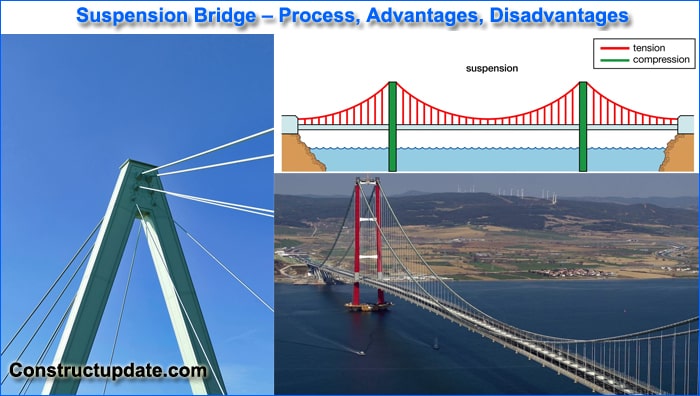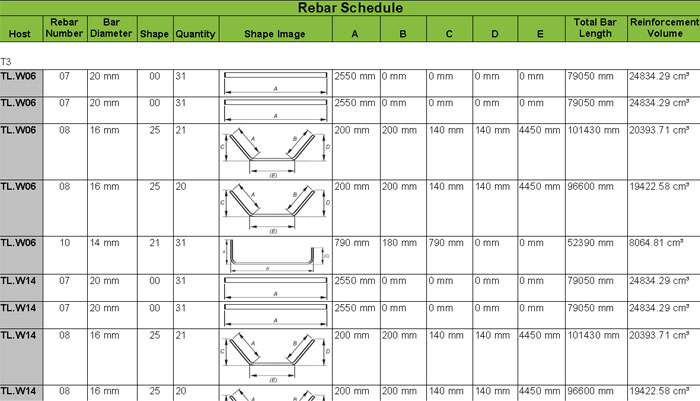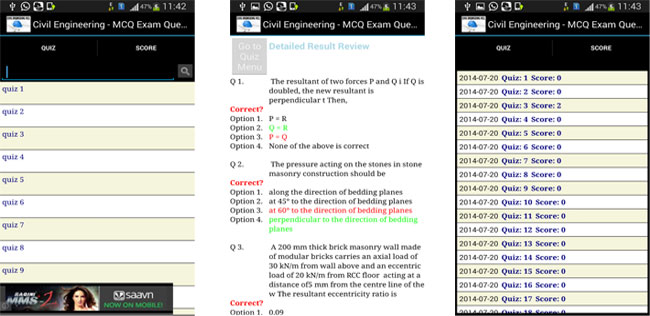All about Suspension Bridge – Process, Advantages, Disadvantages
What is a Suspension Bridge?
In a suspension bridge, the deck is suspended from a network of cables that are mounted on vertical braces. Early in the 19th century, the first contemporary instances of this design started to show up. In the hilly areas of the world, simple bridges without braces have been in use for many years. Let’s try to understand in detail suspension bridges and their construction process, including the advantages and disadvantages in this article.
Cables slung between the towers of suspension bridges support the weight of the deck with their vertical braces.
The deck can curve upward for more clearance or sit level thanks to its design. Many of them were constructed without using falsework.
There must be cables anchored to both ends of the structure for the suspension design to function. Any force acting on the bridge causes tension, which the major cables must withstand. They continue past the pillars to the deck’s supports and then into the ground anchors to give sufficient support.
When communities begin to look at the need for a new span, there are a number of distinct benefits and drawbacks of suspension bridges to take into account.

How to Build a Suspension Bridge?
- The process of building a suspension bridge is very similar to that of building a regular bridge, with the exception of this particular form of bridge.
- The bridge deck slab must be supported by cables, whereas conventional bridge construction does not.
- It is essential to look at the structural elements of a suspension bridge and the use for which it is intended before beginning to learn how to build one.
- The primary supporting cables—often referred to as “catenary”—and piers, which take the shape of tall towers, are among the suspension bridge’s structural elements.
- The major supporting cables are attached with braces and anchorages at both ends of the bridge.
- The foundation and superstructure of a suspension bridge are built first, followed by the building of the piers or towers using conventional techniques.
- The anchor blocks are fixed on both ends of the bridge concurrently with the tower construction in order to secure the primary supporting cables.
- The main cable will be installed after the towers and anchor blocks are put in place.
- The primary supporting cables (Catenary) are made up of tens of thousands of thin wires that are mechanically threaded one by one into two end anchor blocks.
- Following the placement of all the wires, it is secured by being wrapped in steel wires and then coated with resin compound to prevent corrosion.
- Suspenders (vertical steel short ropes) are hung from the main cables once the main cables have been built which, due to the parabolic shape of the main cables, often fluctuates in height and length (smallest in middle span, to the largest in end spans).
- The bridge deck is then put in place as the last stage of construction begins.
- The bridge decks are often installed in prefabricated segments, each of which is placed separately. For the most part, bridge decks are built using steel girders, trusses, or boxes.
- To join the bridge at the middle span, the bridge decks are placed progressively from both towers towards the middle span as they advance simultaneously.
- The major bridge is built first, followed by the building of numerous smaller approaches at the bridge, delivery of the project, and maintenance afterwards.
Components of a Suspension Bridge
Main Cables:
A cable that is fastened at both ends and runs along the top of the bridge. Before it was discovered that a cable comprised of thousands of steel wires would be significantly stronger, this Cable was first constructed as enormous chains. Each cable in certain suspension bridges has more than 10,000 wires. The strongest suspension bridges have been built with these cables.
Suspender Cables:
Although they are constructed similarly to the main cables, these cables are not as thick. These steel wires, which support the deck, are created in the current era.
Deck:
The major part of the bridge where traffic and pedestrians move about is the deck. The span of the bridge is made up of several steel trusses at this section.
Towers:
The towers are where the cables connect in order to form the next tower into the ideal parabolic shape for the strongest hold.
Tower Foundation:
The portion of the foundation that the tower stands on may be on the ground or even submerged.
Building successful below-water foundations takes a lot more time and effort.
Anchors:
At the ends of the bridges, anchors are used to secure the major cables. If there isn’t enough rock to use as anchors, tonnes of concrete can be used to construct the foundation in its place.
The Advantages of Suspension Bridges
- Cost Effective
The materials required to build a suspension bridge are incredibly few. The only additional expenses incurred were labor charges to create it.
- Can Be Built High Up
Over waterways, suspension bridges can be erected to incredible heights. Any place that needs to be able to accommodate passing ships must have this.
- Span Great Lengths
Suspension bridges may span a considerable distance with only a few materials because to the manner they are built and the materials that are employed.
- Has Flexibility
If a suspension bridge is being built in an earthquake-prone region, such as California, this is frequently one of the factors that influence the decision. This is so because the cable system that supports suspension bridges allows them to be flexible. When there are natural disasters like earthquakes, the bridge may “move” with the wind.
- Simple Construction
Since there is no requirement for access from below the bridge while it is being built, it is a suitable option for locations where ships and waterways must remain clean.
Disadvantages of Suspension Bridges
Heavy loads might be challenging for suspension bridges to focus on. The incapacity of this form of bridge to carry concentrated targeted loads may prove to be a significant disadvantage for the high traffic cities and nations given that it can be utilised to span extremely wide distances.
Suspension bridges are susceptible to strong winds. Due to the bridge’s weaker rigidity, strong winds and earthquakes can seriously damage it, causing vibration and, eventually, bridge failure.
A suspension bridge may require a little bit of access from the bottom deck during construction, which can be avoided using cable cable-stayed.
In comparison to other bridge structures, a suspension bridge has a lower feck stiffness.
Important Facts of Suspension Bridges
A suspension bridge that is underpinned has cables below the structure rather than above it.
The longest-spanning suspension bridge in the world is the Akashi-Kaikyo bridge in Japan. It is 6,532 feet in length!
In their earliest forms, these bridges were nothing more than a network of intertwined vines that were employed in prehistoric times. These outdated suspension bridge designs are still in use in rural areas.
There have been numerous occasions when cables have broken, dropping the suspension bridge into the water. In the 1950s, one person known as “Galloping Gertie” accomplished just that.
FAQ
How Are Suspension Bridges Constructed?
A suspension bridge is a form of bridge in which the deck is suspended on vertical braces from below suspension cables. The main suspension cables, main towers, and the anchorages for the cables at either end of the bridge are the primary structural elements of a suspension bridge system.
Construction Material of a Suspension Bridge
Despite a few exceptions, most suspension bridge towers are constructed of steel-reinforced concrete. Suspension Bridge Materials: Supplies for bridges. Asphalt, steel, concrete, stone, and other building materials are some of the main ones used in bridge construction. Iron, wood, aluminium, rubber, and other joint materials are additional materials.





